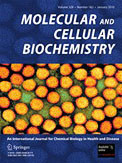Wilhelm J, Ošťádalová I, Vytášek R, Vajner L. Mol Cell Biochem. 2011 Dec;358(1–2):215–20. Epub 2011 Jul 19. IF: 1.272

Ústav lékařské chemie a klinické biochemie
Abstrakt
Reports describing production of reactive oxygen species in neonatal heart are missing. As lysyl oxidase is potentially important source of H2O2, we studied its role during ontogenic development of rat heart. H2O2 was detected in thin sections of developing rat heart by fluorescence microscopy with the use of fluorescence probe 2'-7'-dichlorofluorescin. The experimental design comprised foetuses 21 days after conception, and then the animals sampled on the 1st, 4th, 7th, 10th, 15th, 30th and 60th day after birth. We also used 7-month-old animals as an example of ageing effects. Since the day 4 on, H2O2 was produced only extracellularly up to the day 15, between days 30 and 60 intracellular production was detected as well, and in 7-month-old animals only extracellular production was observed. The specific inhibitors of lysyl oxidase almost completely quenched the H2O2-dependent fluorescence. Starting from day 7, blue autofluorescence specific to oxidized proteins developed in the vessel wall. Intracellular blue autofluorescence specific to autoxidation products developed after day 30. Chloroform extraction diminished the intracellular blue fluorescence, leaving the extracellular fluorescence intact. This confirmed the protein nature of the fluorophores. Lysyl oxidase is significant source of H2O2 in the heart vessel wall during development and H2O2 oxidatively modifies elastin producing protein blue autofluorescence.
-mk-
